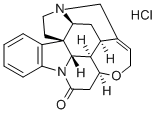Strychnine Sulfate
- CAS NO.:60-41-3
- Empirical Formula: C21H22N2O2.1/2H2O4S
- Molecular Weight: 766.91
- MDL number: MFCD00068328
- EINECS: 200-477-7
- SAFETY DATA SHEET (SDS)
- Update Date: 2025-04-29 17:45:46

What is Strychnine Sulfate?
Chemical properties
Strychnine is a colorless crystalline prisms or white powder. It is odorless; with a bitter taste
The Uses of Strychnine Sulfate
Chiefly in poison baits for rodents.
The Uses of Strychnine Sulfate
central stimulant
General Description
Colorless, odorless, very bitter crystals or white crystalline powder. Has been used as a tonic and stimulant in veterinary medicine. Registered as a rodenticide in the U.S.
Reactivity Profile
STRYCHNINE is an alkaloid derivative. STRYCHNINE is a base and forms water soluble salts with acids. Avoid alkalis, alkali carbonates and bicarbonates, benzoates, dichromates, bromides, iodides, tannic and picric acids, salicylates, borax, gold chloride and other alkaloid precipitants, piperazine, potassium-mercuric iodide. Protect from light. [EPA, 1998] STRYCHNINE is incompatible with the following: Strong oxidizers .
Health Hazard
Violent poison!. Lowest published lethal dose orally in humans is 30 mg/kg.
Fire Hazard
When heated to decomposition, STRYCHNINE emits very toxic fumes of sulfur oxides and nitrogen oxides. Avoid alkalies, alkali carbonates and bicarbonates, benzoates, dichromates, bromides, iodides, tannic and picric acids, salicylates, borax, gold chloride and other alkaloid precipitants, piperazine, potassium-mercuric iodide. Protect from light.
Safety Profile
Poison by ingestion, intraperitoneal, intravenous, and subcutaneous routes. When heated to decomposition it emits very toxic fumes of SOx and NOx. See also STRYCHNINE and SULFATES
Potential Exposure
de, requiring a certified applicator. Strychnine is an alkaloid compound that has been widely used as a rodenticide/bait to kill rodents; a medicine, respiratory stimulant. A potential danger to those involved in the extraction the seeds of the Strychnos nux vomica, Strychnos ignatii (S. sancta Ingnatius), and Strychnos tiente (Upas tree); formulation or application of this rodent poison. The sulfate is used to kill gophers and moles. A common adulterant in illicit street drugs. Listed as a potential WMD biotoxin.
Shipping
UN1692 Strychnine or strychnine salts, Hazard Class: 6.1; Labels: 6.1-Poisonous material.
Incompatibilities
Incompatible with oxidizers (chlorates, nitrates, peroxides, permanganates, perchlorates, chlorine, bromine, fluorine, etc.); contact may cause fires or explosions. Keep away from alkaline materials, strong bases, strong acids, oxoacids, epoxides. Dangerous when heated; forms toxic fumes, including nitrogen oxides. In the body, caffeine may increase the strychnine effect.
Waste Disposal
Consult with environmental regulatory agencies for guidance on acceptable disposal practices. Generators of waste containing this contaminant (≥100 kg/mo) must conform to EPA regulations governing storage, transportation, treatment, and waste disposal. In accordance with 40CFR165, follow recommendations for the disposal of pesticides and pesticide containers. Must be disposed properly by following package label directions or by contacting your local or federal environmental control agency, or by contacting your regional EPA office. Careful incineration has been recommended for disposal. Two procedures are suggested. Pour or sift onto a thick layer of sand and soda ash mixture (90-10). Mix and shovel into a heavy paper box with much paper packing Burn in incinerator. Fire may be augmented by adding excelsior and scrap wood. Stay on the upwind side. Waste may be dissolved in flammable solvent (alcohols, benzene, etc.) and sprayed into fire box of an incinerator with afterburner and scrubber.
Properties of Strychnine Sulfate
| Melting point: | 284-286 °C(lit.) |
| Density | 1.0926 (rough estimate) |
| refractive index | 1.6000 (estimate) |
| solubility | chloroform: clear to hazy |
| pka | 8.26(at 25℃) |
| Merck | 8855 |
| CAS DataBase Reference | 60-41-3(CAS DataBase Reference) |
| EPA Substance Registry System | Strychnine sulfate (60-41-3) |
Safety information for Strychnine Sulfate
| Signal word | Danger |
| Pictogram(s) |
 Skull and Crossbones Acute Toxicity GHS06  Environment GHS09 |
| GHS Hazard Statements |
H410:Hazardous to the aquatic environment, long-term hazard |
| Precautionary Statement Codes |
P260:Do not breathe dust/fume/gas/mist/vapours/spray. P264:Wash hands thoroughly after handling. P264:Wash skin thouroughly after handling. P270:Do not eat, drink or smoke when using this product. P271:Use only outdoors or in a well-ventilated area. P273:Avoid release to the environment. |
Computed Descriptors for Strychnine Sulfate
Strychnine Sulfate manufacturer
New Products
4,4-Difluoropiperidine hydrochloride tert-butyl 9-methoxy-3-azaspiro[5.5]undecane-3-carboxylate Indole Methyl Resin N-Isopropylurea N,N-Dicyclohexylcarbodiimide(DCC) MELDRUMS ACID 5-METHYLISOXAZOLE-4-CARBOXYLIC ACID Magnessium Bis glycinate Zinc ascorbate 1-bromo-2-butyne 2-acetamidophenol 9(10H)-anthracenone Erythrosin B, 4-Piperidinopiperidine 2-((4-morpholinophenylamino) (methylthio) methylene) malononitrile 2,4-dihydroxybenzaldehyde 3-(4-morpholinophenylamino)-5-amino-1H-pyrazole-4-carbonitrile Methyl 2-methylquinoline-6-carboxylate 2,6-dichloro-4-nitropyridine 4-Bromo-2-chlorobenzonitrile 2-(benzylamino)acetic acid hydrochloride 4-(tert-Butoxycarbonylamino)but- 2-ynoic acid 3,4-dihydro-2H-benzo[b][1,4]dioxepine 1-Phenyl-1-cycloprppanecarboxylicacidRelated products of tetrahydrofuran








You may like
-
 60-41-3 Strychnine sulfate 99%View Details
60-41-3 Strychnine sulfate 99%View Details
60-41-3 -
 Strychnine hemisulfate salt CAS 60-41-3View Details
Strychnine hemisulfate salt CAS 60-41-3View Details
60-41-3 -
 Strychnine Sulphate Powder APIView Details
Strychnine Sulphate Powder APIView Details
60-41-3 -
 3-(4-amino-1-oxoisoindolin-2-yl)-1-methylpiperidine-2,6-dione 98%View Details
3-(4-amino-1-oxoisoindolin-2-yl)-1-methylpiperidine-2,6-dione 98%View Details -
 20677-73-0 (2,2-diethoxyethyl)methylamine 98%View Details
20677-73-0 (2,2-diethoxyethyl)methylamine 98%View Details
20677-73-0 -
 3-(4-(hydroxyamino)-1-oxoisoindolin-2-yl)piperidine-2,6-dione 98%View Details
3-(4-(hydroxyamino)-1-oxoisoindolin-2-yl)piperidine-2,6-dione 98%View Details -
 57381-49-4 2-bromo-4-chlorobenzonitrile 98%View Details
57381-49-4 2-bromo-4-chlorobenzonitrile 98%View Details
57381-49-4 -
 4,6-dichloropyrimidine-5-carbaldehyde 98%View Details
4,6-dichloropyrimidine-5-carbaldehyde 98%View Details
5305-40-8
